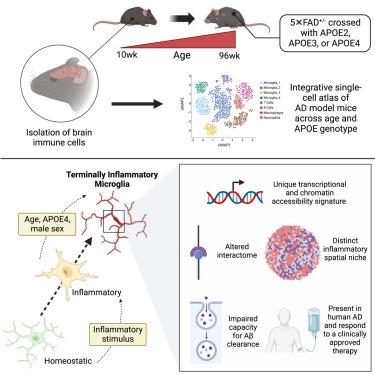Immunity ( IF 32.4 ) Pub Date : 2023-12-29 , DOI: 10.1016/j.immuni.2023.12.001 Alon Millet , Jose Henrique Ledo , Sohail F. Tavazoie

|
The dominant risk factors for late-onset Alzheimer’s disease (AD) are advanced age and the APOE4 genetic variant. To examine how these factors alter neuroimmune function, we generated an integrative, longitudinal single-cell atlas of brain immune cells in AD model mice bearing the three common human APOE alleles. Transcriptomic and chromatin accessibility analyses identified a reactive microglial population defined by the concomitant expression of inflammatory signals and cell-intrinsic stress markers whose frequency increased with age and APOE4 burden. An analogous population was detectable in the brains of human AD patients, including in the cortical tissue, using multiplexed spatial transcriptomics. This population, which we designate as terminally inflammatory microglia (TIM), exhibited defects in amyloid-β clearance and altered cell-cell communication during aducanumab treatment. TIM may represent an exhausted-like state for inflammatory microglia in the AD milieu that contributes to AD risk and pathology in APOE4 carriers and the elderly, thus presenting a potential therapeutic target for AD.
中文翻译:

老年痴呆症和 APOE4 基因型阿尔茨海默氏症大脑中积聚了疲惫状的小胶质细胞群
晚发性阿尔茨海默病 (AD) 的主要危险因素是高龄和APOE4遗传变异。为了研究这些因素如何改变神经免疫功能,我们在携带三种常见人类APOE等位基因的 AD 模型小鼠中生成了脑免疫细胞的综合纵向单细胞图谱。转录组和染色质可及性分析确定了一个反应性小胶质细胞群体,该群体由炎症信号和细胞内在应激标记物的伴随表达定义,其频率随着年龄和APOE4负担而增加。使用多重空间转录组学,可以在人类 AD 患者的大脑(包括皮质组织)中检测到类似的群体。我们将这一群体命名为终末炎症小胶质细胞 (TIM),在阿杜卡单抗治疗期间表现出淀粉样蛋白-β 清除缺陷和细胞间通讯改变。TIM 可能代表 AD 环境中炎症小胶质细胞的疲惫状状态,导致APOE4携带者和老年人的 AD 风险和病理,从而为 AD 提供潜在的治疗靶点。



























 京公网安备 11010802027423号
京公网安备 11010802027423号